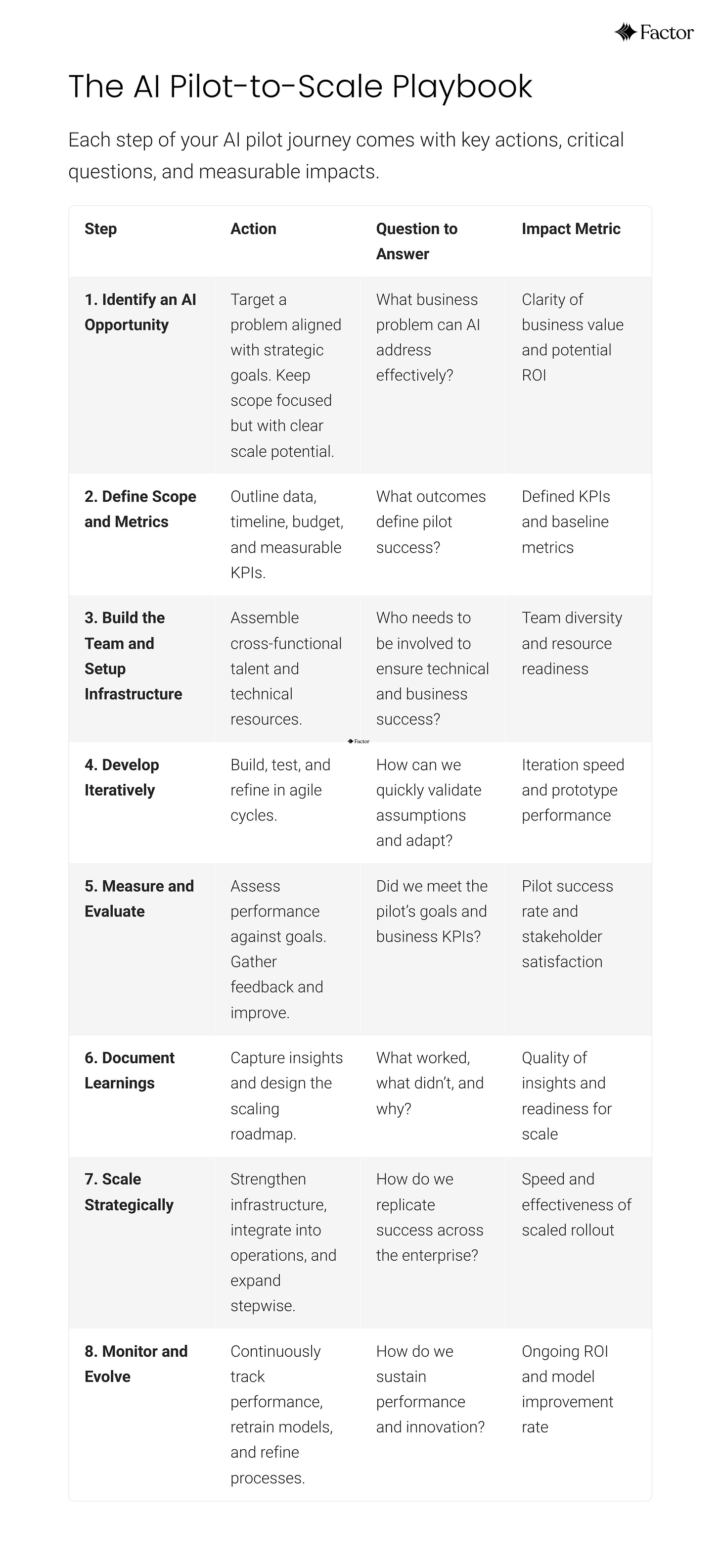Hi 👋🏻, Naveen here — welcome to AI x Factor, where I explore the fast-evolving intersection of AI, leadership, and technology.
AI is transforming industries. But the difference between success and failure often lies in how organisations adopt it.
The smartest approach? Pilot AI first. Then scale.
Why? Because starting small:
Reduces risk
Validates value
Builds momentum for wider adoption
Yet, many companies still get stuck in pilot phase. Studies show that 70–90% of AI pilots never scale to production, leaving huge value untapped.
The companies that do scale — like Microsoft, Google, and Accenture — see transformative results.
According to BCG, organisations that successfully scale AI achieve up to 3× higher revenue impact.
In this post, I’ll share a playbook on how to pilot AI effectively and scale it for lasting business impact.
Let’s dive in!
Benefits of AI Pilots
Starting small has powerful advantages:
Lower risk: Test AI on a limited scale and learn safely.
Proof of value: Gather measurable results before large-scale investment.
Continuous learning: Iterate, refine, and strengthen models and processes.
Business alignment: Validate that AI truly solves a meaningful problem.
Cultural buy-in: Early success stories win stakeholder confidence.
In short, AI pilots act as a bridge — transforming experimentation into enterprise-ready innovation.
Why Do Many AI Pilots Fail to Scale?
Even promising pilots can struggle to achieve full-scale adoption. The reasons are often systemic rather than technical.
Lack of scaling infrastructure: Systems may not be designed to handle growth, real-time data, or continuous learning loops.
Poor user experience: If solutions are not intuitive or aligned with how people work, they simply won’t be used.
Unclear benefits and strategy: Without a clear business case or AI roadmap, pilots lose momentum after initial success.
Internal resistance and lack of fluency: Teams may lack the skills, understanding, or trust needed to adopt AI confidently.
Scaling AI requires more than technical readiness — it demands organisational alignment, robust infrastructure, and human adoption.
What Are the Benefits of Scaling AI?
When AI scales effectively, the results can be transformative.
Higher revenue impact: Scaled AI initiatives can deliver up to 3× greater revenue impact compared to pilots alone.
Improved profitability: Organisations may achieve 30% higher EBIT (Earnings Before Interest and Taxes).
Transformative results: Company-wide AI adoption drives lasting innovation, operational efficiency, and strategic agility.
Scaling isn’t just about expansion — it’s about realising the full potential of AI across the enterprise.
Key Steps for Successful AI Pilots
To ensure your pilot leads to scalable success, apply these guiding principles:
Set clear goals: Define success metrics upfront (e.g. accuracy, time saved, ROI).
Secure executive sponsorship: Assign a business owner who champions the initiative.
Choose a high-impact use case: Focus on real, solvable pain points with manageable complexity.
Need help identifying the right use case? Factor helps businesses uncover high-value AI opportunities and turn them into real results. Let’s talk.
Ensure data readiness: Clean, accessible data is the foundation of every AI project.
Build a cross-functional team: Combine data scientists, business experts, and engineers.
Adopt an agile mindset: Prototype quickly, test, and iterate.
Design for scale: Use scalable platforms and avoid hard-coded or isolated prototypes.
Foster innovation culture: Encourage learning, collaboration, and openness to experimentation.
The AI Pilot-to-Scale Playbook
Factor can help: we partners with business to accelerate this journey — from identifying high-value AI opportunities to piloting and scaling. Let’s talk.
We help you:
Discover the right AI use cases aligned with strategic goals.
Build pilots that demonstrate measurable business value.
Create a scalable AI roadmap backed by strong governance and infrastructure.
Pilot AI first. Then scale — confidently with Factor.
Common Pitfalls – And How to Avoid Them
No plan to scale: Define success criteria and ownership from day one.
Weak sponsorship: Ensure a business leader is accountable for results.
Fuzzy metrics: Set measurable KPIs to justify scaling.
Non-scalable prototypes: Build on production-ready platforms.
Data issues: Test real integrations early, not just clean samples.
Neglecting users: Involve end-users to ensure adoption and trust.
Scaling too fast: Validate thoroughly before going enterprise-wide.
Avoiding these traps ensures your pilot transitions smoothly from concept to company-wide capability.
Final thoughts – Pilot Smart. Scale Bold.
Piloting AI is not about experimentation for its own sake. It’s about learning fast and scaling what works.
The journey to AI maturity looks like this:
Start small to minimise risk.
Learn and refine through iteration.
Scale proven solutions to drive enterprise transformation.
The organisations that master this cycle — like Microsoft, Google, and Accenture — continuously innovate and lead their industries.
Pilot AI first. Then scale. That’s not just a strategy; it’s a mindset for sustainable, intelligent growth.
Pilot AI First. Then Scale — With Confidence.
While others are still drafting strategies, leading businesses are already realising measurable results from targeted AI pilots. Factor partners with leadership teams to identify high-impact pilot opportunities and build the foundation for scalable, sustainable AI transformation — delivering ROI in weeks, not years.
In your complimentary Discovery Call, we’ll explore:
✅ Your organisation’s AI readiness and strategic priorities
✅ Pilot initiatives that align with measurable business outcomes
✅ Scalable pathways to move from proof-of-concept to enterprise value
No hype. No generic templates. Just a clear, data-informed view of how to begin your AI journey with confidence.
Book Your free AI Discovery Session today.
Factor: Your AI multiplier
Your opinion matters!
Until next time,
Naveen & AI x Factor Team





